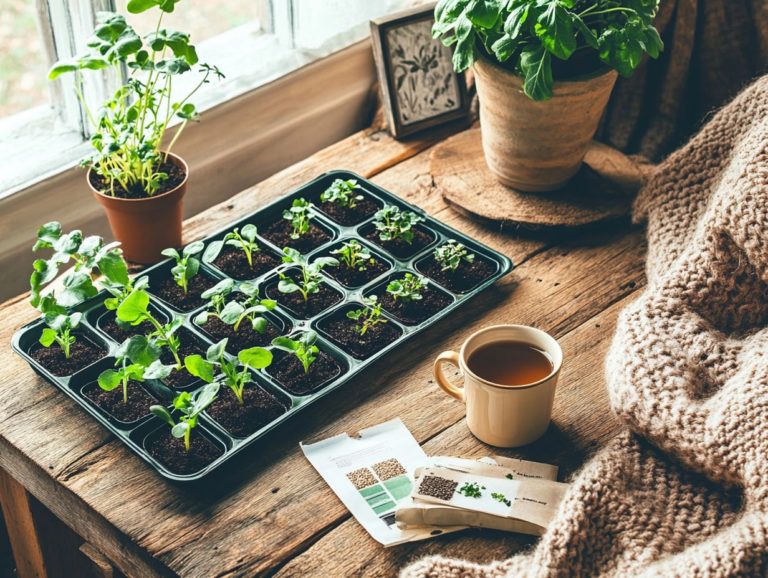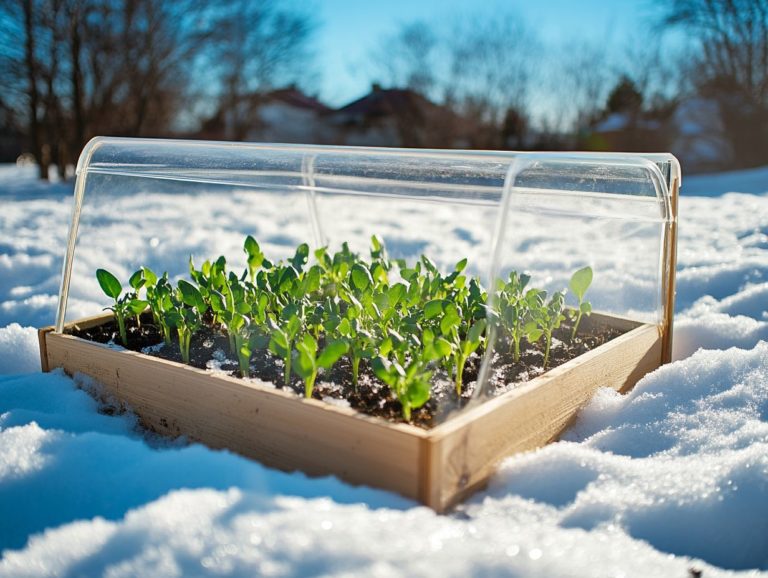Planning Your Winter Vegetable Garden Layout
Winter gardening, also known as vegetable gardening, may seem challenging at first glance, yet it offers many benefits that can turn the chilly months into a time of plenty!
By choosing the right cold-resistant vegetables and designing an efficient garden layout, you can keep your passion for gardening alive while savoring homegrown produce when other options are scarce.
Discover how to effectively prepare, protect, and optimize your winter garden, ensuring that you reap a bountiful harvest even during the cold season.
Contents
- Key Takeaways:
- Benefits of a Winter Vegetable Garden
- Choosing the Right Vegetables for Winter
- Preparing Your Garden for Winter
- Creating a Winter Garden Layout
- Maximizing Space in a Small Garden
- Protecting Your Winter Garden
- Harvesting and Storing Winter Vegetables
- Frequently Asked Questions
- 1. What is the best time to start planning my winter vegetable garden layout?
- 2. What factors should I consider when planning my winter vegetable garden layout?
- 3. Can I use the same layout for my winter vegetable garden as my summer garden?
- 4. How can I maximize space in my winter vegetable garden layout?
- 5. Are there any vegetables that should be avoided in a winter vegetable garden layout?
- 6. What are some tips for maintaining a successful winter vegetable garden layout?
Key Takeaways:
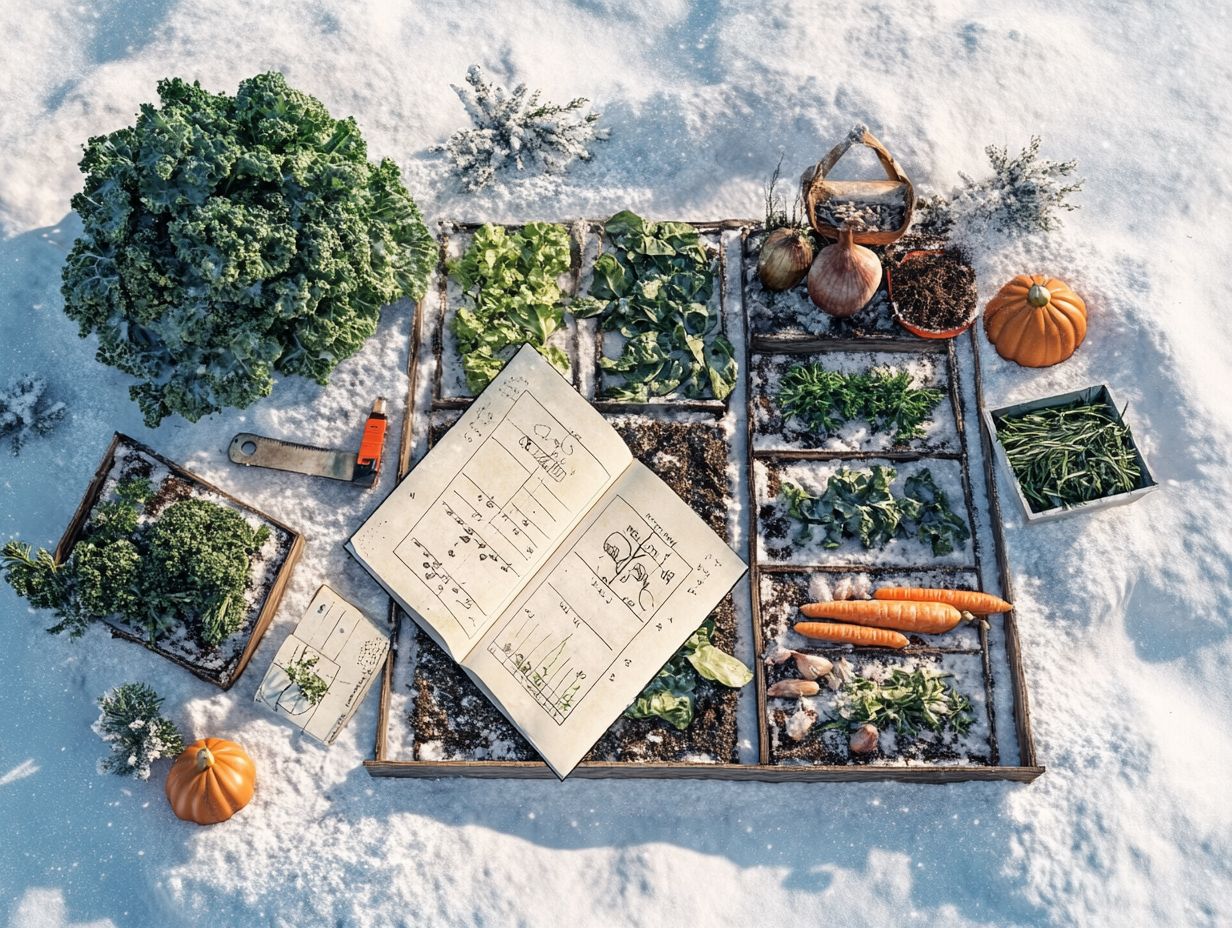
- Don’t let the cold weather stop you from gardening! Winter vegetable gardens have numerous benefits, such as providing fresh produce, increasing biodiversity, and improving soil health through the compost benefits of organic matter.
- Choose cold-weather vegetables that thrive in lower temperatures, like kale, carrots, and Brussels sprouts. Consider planting a mix of root vegetables, leafy greens, and vegetables like broccoli and cabbage for a diverse harvest.
- Prepare your garden for winter by cleaning up debris, adding compost, and covering with mulch. A well-insulated and nourished garden will help your winter vegetables survive and thrive, allowing you to enjoy flavors and freshness throughout the cold season.
Benefits of a Winter Vegetable Garden
Winter gardening offers many benefits beyond just enjoying fresh vegetables. By gardening in winter, you can savor homegrown produce during the colder months, enriching your emotional well-being as you connect with nature and witness your crops thrive even amidst the frost.
Adopting four-season growing methods lets you enjoy fresh produce year-round. This journey fosters a profound appreciation for seasonal cycles and the beauty of the natural world.
Why Winter Gardening is Worth the Effort
Engaging in winter gardening might seem daunting at first, but the myriad benefits make it an endeavor truly worth your time!
Beyond the sheer joy of nurturing life against a stark winter landscape, this practice offers a remarkable outlet for your emotional well-being. Sowing seeds and tending to plants grants you a sense of purpose and a deeper connection to nature, cultivating mindfulness during a season often marked by solitude.
Picture the satisfaction of harvesting vibrant vegetables in months when fresh produce feels like a rarity! By using seasonal techniques and selecting hardy crop varieties, you can ensure a continuous yield, all while embracing an inventive approach to gardening that pushes your creative boundaries.
Choosing the Right Vegetables for Winter
Choosing the right vegetables for winter gardening is essential for cultivating a thriving cold-weather garden, allowing you to savor a delightful array of fresh and nutritious selections even amidst the frost.
Leafy greens such as spinach and lettuce flourish in cooler temperatures, while root vegetables like carrots and beets can be harvested throughout the winter months, providing sustenance and variety.
By incorporating vegetables like broccoli and kale, along with robust alliums such as garlic and onions, you can ensure a bountiful harvest. Don’t forget to include herbs like parsley, which can elevate your winter dishes with their vibrant flavors.
Start planning your winter garden today and enjoy fresh vegetables all season long!
Best Cold-Weather Vegetables
When you re planning a winter garden, certain cold-weather vegetables truly shine for their resilience and flavor. These are perfect picks for any winter gardening enthusiast.
These hardy crops thrive in the cold. Believe it or not, they can taste even better after a frost, appealing to both culinary aficionados and home cooks alike. Take kale, for instance. It s not just a nutrient-rich addition to your salads and soups; it s also remarkably adaptable to different soil types.
Then there are root vegetables like carrots and beets, which thrive in the cold. They develop deeper flavors and a delightful sweetness that elevate your dishes. What s even better? These vegetables require minimal maintenance during the winter months, allowing you to enjoy the fruits of your labor with ease.
Their ability to withstand harsh conditions makes them invaluable options for anyone looking to expand their winter culinary repertoire.
Preparing Your Garden for Winter
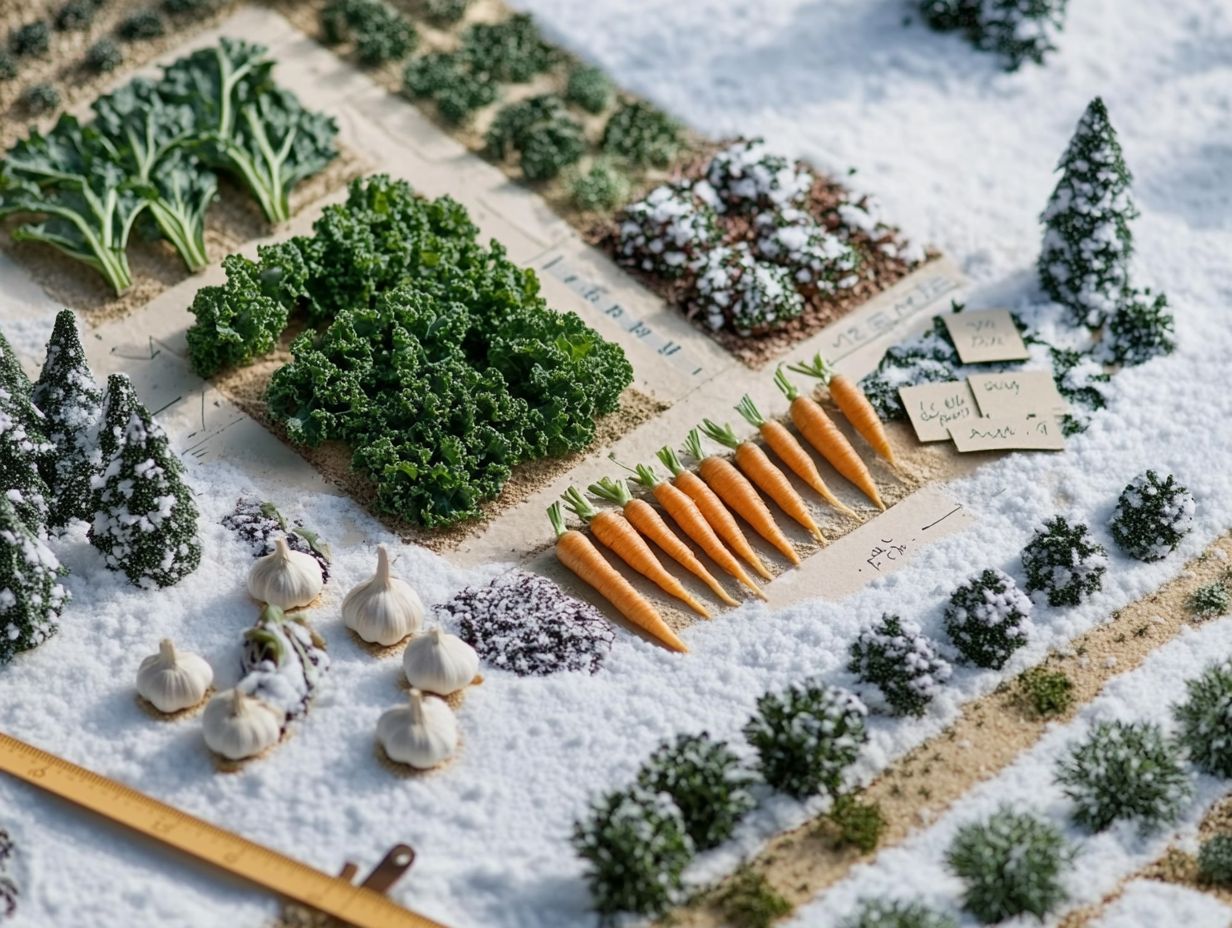
Get ready for winter! Preparing your garden now will ensure a thriving vegetable garden all season. Start by conducting soil tests to evaluate nutrient levels. This will guide you in adding natural materials to improve the soil.
Create a planting schedule to maximize the growth potential of your winter crops. This ensures they re primed for harvest at just the right moment, even as temperatures begin to plummet.
Steps for Winterizing Your Garden
Winterizing your garden is an essential endeavor that dramatically enhances its performance during the chilly months. This sets the stage for success come spring. By dedicating some time to winterize, you safeguard your plants against harsh weather and keep the soil healthy and nutrient-rich.
Each step counts! Conduct soil tests, apply compost, and mulch to create a thriving environment for your perennials and other plants. The advantages of winterizing go beyond mere survival; they pave the way for vibrant growth when spring arrives, ultimately fostering a flourishing garden for the upcoming growing season.
To kick off the process, start with soil testing. This crucial step reveals nutrient deficiencies and pH levels. This information enables you to amend your soil with the right compost, an organic treasure that enriches your soil while enhancing its structure and drainage.
Next, apply a generous layer of mulch. This not only helps conserve moisture but also provides cozy insulation for your plant roots, shielding them from the biting cold. Protecting your perennials with burlap or other protective covers minimizes frost damage, ensuring they emerge healthy and ready to thrive as spring unfolds.
Creating a Winter Garden Layout
Crafting an efficient winter garden layout is crucial for maximizing your space and ensuring the successful growth of various cold-weather crops. By thoughtfully planning your garden design, you can optimize space usage, enabling a variety of vegetables to flourish. Consider incorporating the top 10 winter vegetables for your garden, including leafy greens and root vegetables, even in a confined area.
By emphasizing four-season growing techniques within your layout, you enhance your yields and transform your gardening experience into a more productive endeavor throughout the winter months.
Considerations for Optimal Layout
When designing the perfect winter garden layout, several key considerations can significantly impact the success of your cold-weather crops, including tips for sustainable winter gardening.
Start by assessing the sunlight your garden receives and strategizing the placement of taller plants. It s essential to think about how each element interacts within the space. If you re planning a winter garden, prioritize companion planting, which means growing different plants together that support each other’s growth.
Carefully organizing your space ensures that each plant has the room it needs to thrive without competing for vital nutrients. By incorporating a thoughtful planting schedule, you can maximize your harvest potential, ensuring a continuous supply of produce throughout the winter months. This approach makes your gardening endeavor efficient and highly rewarding.
Maximizing Space in a Small Garden
Maximizing space in a small garden demands thoughtful strategies to cultivate a diverse array of winter vegetables without sacrificing productivity. By employing techniques like moving young plants and implementing crop rotation, you can utilize every inch of your garden to its fullest potential.
This approach enhances your winter harvest and supports sustainable gardening practices while fostering healthy soil.
Tips for Growing More in Less Space
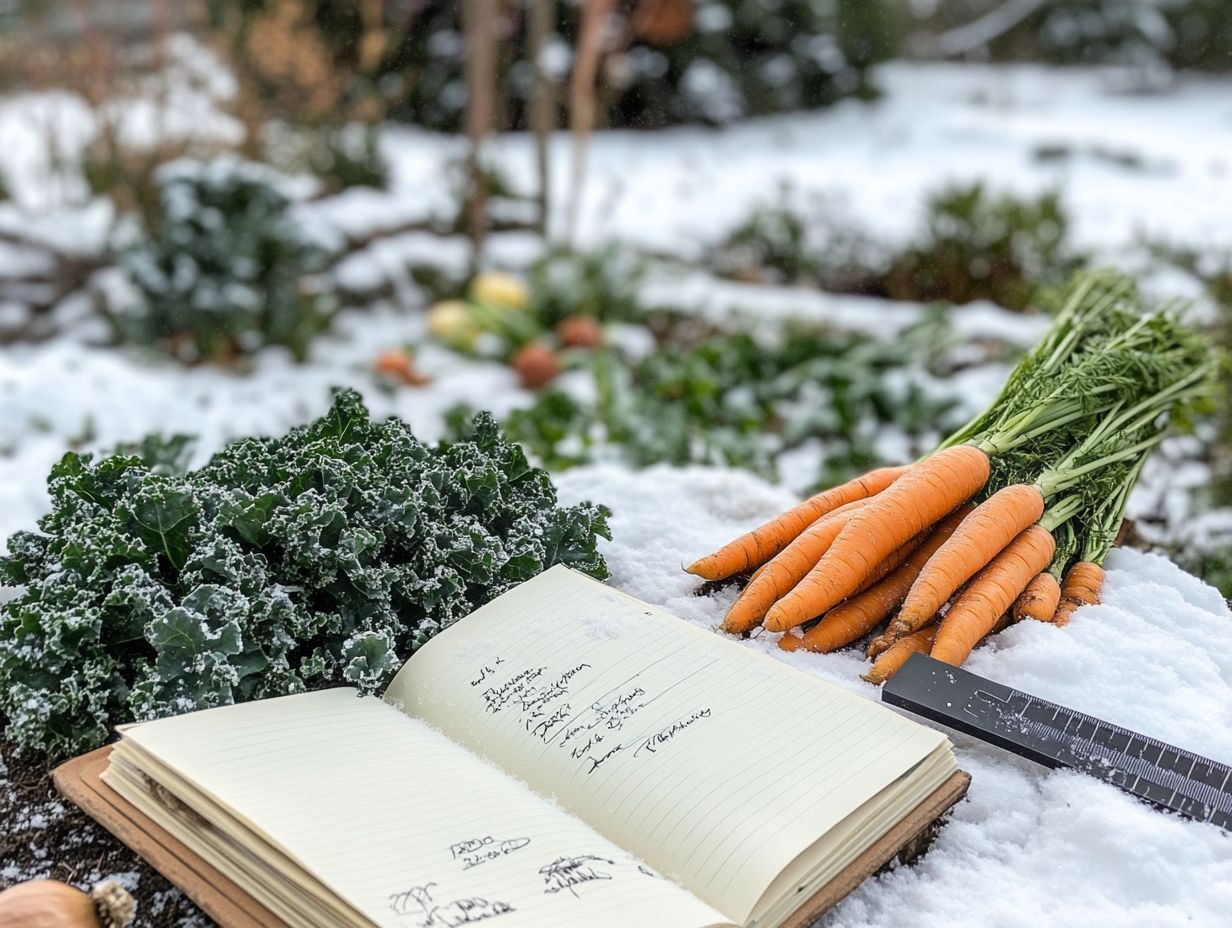
To grow more in less space, adopt innovative techniques that promote efficiency. These methods maximize yield and ensure you get the most from your garden.
Incorporate vertical gardening to use your space effectively. This method allows you to grow a variety of plants using trellises or wall planters, significantly boosting your overall production.
Utilizing planting together for better growth encourages beneficial relationships among plants, enhancing growth and pest resistance. Selecting high-yield varieties is crucial; opting for hybrids known for their prolific outputs can greatly augment your harvests.
Timing is everything moving young plants at the right stage ensures they take root effectively, promoting a flourishing garden. Regular crop rotation, along with soil testing and compost benefits, prevents soil depletion and reduces pest and disease buildup, making it essential for sustainable gardening.
Protecting Your Winter Garden
Shield your winter garden from frost and snow to keep your crops thriving throughout the cold season. Employ various techniques such as row covers, cold frames, and mulching to effectively shield your plants from harsh winter elements.
These measures protect your plants and stretch your harvest well into winter. Embracing these protective strategies enhances your winter gardening experience, allowing you to savor the delights of homegrown produce in chilly months.
Methods for Protecting Plants from Frost and Snow
You have several effective strategies to protect your winter garden plants, such as carrots and beets, from frost and snow. This ensures their survival and productivity.
One practical approach is to use blankets or tarps. These create a cozy microclimate that guards your plants against brutal temperatures. Adding windbreaks like strategically placed shrubs or fences can also shield your delicate plants from harsh winds that amplify winter chill.
Constructing cold frames is another wise tactic. These low structures trap heat and sunlight while protecting against extreme weather, allowing your tender seedlings to thrive. Each of these methods boosts plant resilience and contributes to a healthier, more robust garden yield during colder months.
Harvesting and Storing Winter Vegetables
Harvesting and storing winter vegetables with care is crucial for preserving their quality and nutritional value. This meticulous approach allows you to savor the fruits of your labor long after frost has settled.
Best Practices for Extending the Life of Your Harvest
To extend the life of your harvested winter vegetables, adhering to best preservation practices is essential. Utilizing methods such as cool storage, which maintains lower temperatures and humidity levels, significantly enhances the longevity of your vegetables.
Carrots and potatoes, in particular, thrive in these conditions, helping to retain their delightful texture and flavor. For other varieties, canning offers a wonderful opportunity to savor seasonal produce throughout the year.
Freezing effectively locks in nutrients and freshness, making it a popular choice. Whichever method you select, proper handling is crucial; thoroughly wash your produce, remove any damaged parts, and ensure your containers are pristine to prevent spoilage.
Creating optimal conditions is vital, as temperature, light, and moisture can all impact the lifespan of these nutritious treasures, particularly during the Persephone Period.
Frequently Asked Questions
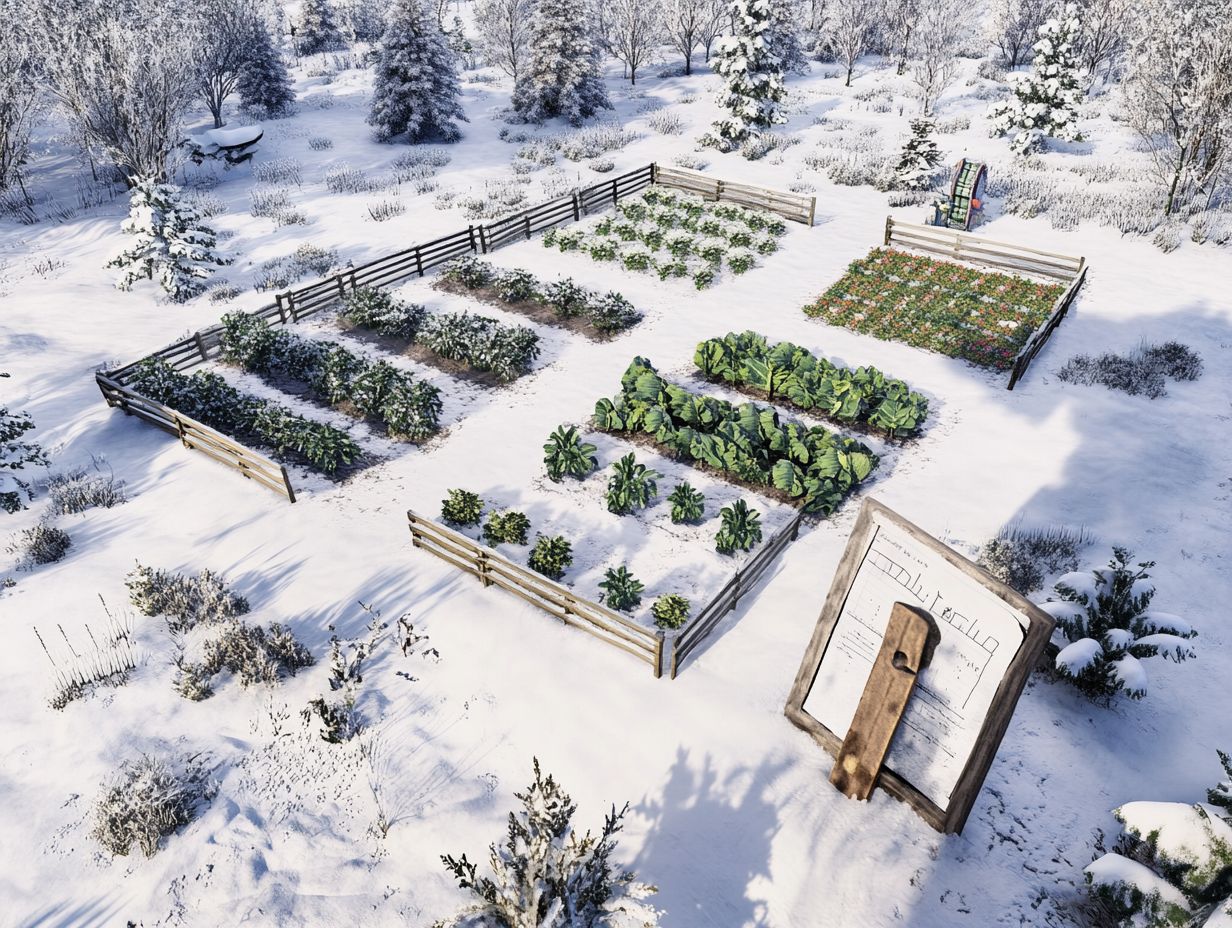
1. What is the best time to start planning my winter vegetable garden layout?
The best time to start planning your winter vegetable garden is late summer or early fall. This timing allows you to prepare the soil and explore utilizing vertical gardening in winter to select the right vegetables for the colder months.
2. What factors should I consider when planning my winter vegetable garden layout?
Consider the amount of sunlight and available space. Also, note the vegetable types that thrive in winter, and for a fun project, check out planning a winter garden for kids, along with the average temperatures and frost dates in your area.
3. Can I use the same layout for my winter vegetable garden as my summer garden?
A different layout is recommended for winter vegetables, as they have unique needs regarding space, sunlight, and temperature. Understanding soil needs for winter vegetables is also crucial for successful growth.
4. How can I maximize space in my winter vegetable garden layout?
Maximize space by using raised beds or vertical gardening. Staggering your vegetable planting can also help you use space efficiently.
5. Are there any vegetables that should be avoided in a winter vegetable garden layout?
Avoid vegetables like tomatoes and peppers, as they don t do well in cold. Focus instead on hardy options such as kale, Brussels sprouts, and carrots.
6. What are some tips for maintaining a successful winter vegetable garden layout?
Regularly check for pests and water your plants as needed. Protect them from harsh weather with row covers or cold frames to extend the growing season.




